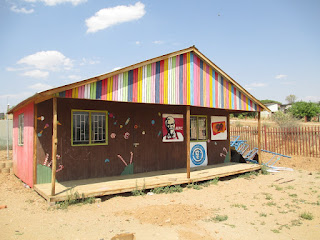After an eye-opening, relaxing and educational trip to the south, the 13th week of classes eliciting topics ranging from religion and H.I.V. &A.I.D.s to political party structures in the United States and Namibia.
 |
| Religion students participating in an HIV/AIDS role play |
In religion Evan Binder and Katylen Stremer lead the class on a discussion about the role which the church should play in facilitating and advocating awareness about H.I.V. and A.I.D.s. Instead of the usual question and answer forum, we were each assigned a role as different members within a community. Each student then responded to a series of questions concerning the issue of H.I.V. A.I.D.s within religious communities with the values and beliefs of whatever character they happen to be playing in mind. I really enjoyed this creative and unique way of facilitating discussion.
With the last excursion out of the way and the ever approaching final integrative projects forthcoming, it has really started to sink in this week that our time in Namibia is slowly coming to an end. This realization came in no greater sense than in our final wrap up session for our internship course on Tuesday. During this session we took the time to reflect and look back on our journey within the context of the internship course and experience. We revisited the initial fears we had and compared them to our current state of being and feeling about the internship experience. We focused on what we felt we gained in terms of knowledge, skills, and attitude, we then applied these three aspects to what we felt we contributed to the host organization.
Having come off an exceptional summer internship at my local county attorney’s office this past summer, coupled with my being of African origin, I felt I was ready for and could handle anything Namibia threw at me. I thought since NamRights was also a public service entity it would possess the same dynamic’s between its employees as I had found at the county attorney’s office. I pictured everyone having their own set of objectives and workload to accomplish each day. In my mind I pictured having my own little desk, with my own work load specifically assigned for me to accomplish each day.
 |
| Buay and his coworkers at NamRights |
I can only describe the environment and culture which I found at NamRights as laid back and relaxed. Often when there is not a press release, or pending documents to compile into electronic form, conversation and discourse consume our entire day. Another difference is the high level of freedom I have been given. Due to the lack of an outlined project and apart from my assigned duties of editing and revising press releases, I have the academic freedom to research and respond to any news articles or issues throughout Namibia or the globe as I desire. I’ve learned to be much more flexible and not so constrained and dictated by schedules, but instead to just go with the flow. I feel I have also provided my host organization with a different perspective upon which to view and analyze issues. I have learned much more then I could ever reciprocate, during my time with NamRights.













